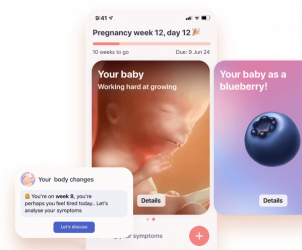Femia > hcg calculator
Beta hCG doubling time calculator
hCG level calculator is an auxiliary tool that helps you keep an eye on your beta hCG levels to analyze pregnancy health and progression



| Week of Pregnancy | HCG Range mIU/mL | HCG Doubling Rate: 18-25 Years | HCG Doubling Rate: 25-35 Years | HCG Doubling Rate: 45+ Years |
|---|---|---|---|---|
| 3 | 5-50 | Every 48 hours | Every 48-72 hours | Every 48-72 hours |
| 4 | 5-426 | Every 48 hours | Every 48-72 hours | Every 48-72 hours |
| 5 | 18-7,340 | Every 48-72 hours | Every 48-72 hours | Every 72-96 hours |
| 6 | 1,080-56,500 | Every 48-72 hours | Every 48-72 hours | Every 72-96 hours |
| 7 | 7,650-229,000 | Every 72 hours | Every 72 hours | Every 72-96 hours |
| 8 | 25,700-288,000 | Every 72-96 hours | Every 72-96 hours | Every 96 hours |
| 9-12 | 13,300-253,000 | Stabilization | Stabilization | Stabilization or slowing |
| 13-16 | 4,000-165,400 | Stabilization or slight decline | Stabilization or slight decline | Stabilization or slight decline |
| 17-24 | 4,000-65,000 | Stabilization | Stabilization | Stabilization |
| 25-40 | 3,640-117,000 | Possible slight decline | Possible slight decline | Possible slight decline |
- Updated Feb 25, 2025
- Published
CRAFTED BY HUMAN
Crafted by human At Femia, we provide accurate and up-to-date information at every stage of your journey, from trying to conceive, pregnancy and postnatal support. All content is created by a real person based on in-depth research and own professional experience. Femia ensures that you will receive expert advice, strict accuracy and a personalized approach from our authors/medical experts. Learn more about our editorial policy.
FACT CHECKED
Fact checked At Femia Health, we maintain the highest standards of editorial excellence in delivering content focused on helping you conceive, guiding you through pregnancy, and supporting you postpartum. Explore our content review principles to learn how we ensure the accuracy and quality of our health and lifestyle tips for every stage of your journey.
What is a Beta hCG calculator and what does hCG show?
An hCG level calculator helps monitor beta hCG levels to track pregnancy progression and health. By analyzing quantitative blood tests, it estimates hCG increase and doubling time. However, levels can vary between women and stages, so consulting a healthcare provider for accurate interpretation is essential. Tracking hCG can help track pregnancy progression and development, and identify early pregnancy complications, particularly for those in the early stages or after IVF.
The hCG beta calculator is primarily used by expectant mothers and healthcare providers to:
- Confirm pregnancy through rising hCG levels and compare the results to reference ranges.
- Ensure that a pregnancy is progressing normally.
- Assess the risk of miscarriage, ectopic pregnancy, or missed miscarriage.
- Monitor hCG levels after a molar pregnancy, trophoblastic disease, or miscarriage to ensure they return to pre-pregnancy levels.
- Track hCG levels in cases of gestational trophoblastic neoplasia (choriocarcinoma) as part of oncological monitoring.
- Monitor outcomes of assisted reproductive technologies, such as IVF, including unsuccessful implantation and multiple pregnancies.
- Assist in the evaluation of vanishing twin syndrome or ovarian hyperstimulation syndrome (OHSS) after IVF.
How to use an hCG calculator
Using an hCG levels calculator is rather intuitive. To get started, you need to input the following data into the relevant calculator boxes:
- First test hCG level
- Second test hCG level
- The time between tests in days or hours
After entering your data, the results should be interpreted based on the following aspects:
- A comparison of current hCG levels to normal indicators to see whether they’re within the norm, high, or low.
- A comparison of the current doubling time of hCG levels to average indicators for your term.
- An assessment of the dynamics of the increase in hCG levels to identify potential issues early on.

Understanding hCG doubling time
Doubling time is one of the core metrics calculated by a beta hCG calculator. It defines the time it takes for hCG levels to double in your blood, produced by the developing placenta after implantation.
The typical pattern of hCG concentrations is as follows:
- 0–4 weeks: hCG levels double every 31–72 hours.
- 4–6 weeks: Doubling typically takes 48–96 hours.
- 6–7 weeks: The doubling time continues to slow, often extending to 96 hours.
- 8–11 weeks: hCG levels reach their peak (commonly 100,000–200,000 mIU/ml) before gradually declining.
Here’s a chart of normal hCG doubling time in relation to different hCG levels:
| hCG level | Estimated doubling time |
|---|---|
| < 1,200 mIU/ml | 30–72 hours |
| 1200–6000 mIU/ml | 72–96 hours |
| > 6,000 mIU/ml | 96+ hours |
Deviations from this pattern may suggest the need for further evaluation, as they can be associated with conditions such as miscarriage or ectopic pregnancy. However, it’s important not to focus on the doubling time alone. Every pregnancy is unique, and hCG levels might not double but still be within an acceptable range. In cases of abnormal trends, follow-up testing after 48-72 hours is typically recommended, but further evaluation, including ultrasound, may be necessary. Consultation with a healthcare provider is always advised.
What do different hCG levels mean?
When using an hCG doubling time calculator, you’ll be tracking your hCG levels regularly. Let’s briefly define what different levels of this hormone might indicate in early pregnancy.
Normal
Most over-the-counter pregnancy tests detect hCG levels from 25 mIU/ml, so anything beyond this number is considered to be positive for pregnancy. In weeks 3 to 4, the range between 5–426 mIU/ml is considered a norm. After week 4, hCG levels typically rise progressively. You can use an hCG chart to see if your indicators are within the norm.
For week 5, the normal hCG level range is between 18–7,340 mIU/ml. Anything within this range is considered a norm.
Low
HCG levels that are lower than typical could indicate:
- Possible miscarriage
- Blighted ovum
- Ectopic pregnancy
At the same time, it could mean a miscalculation of pregnancy dating. For example, if you’re in week 5, and your hCG level is under 18 mIU/ml, it’s under the normal range.
High
Abnormally high levels of hCG could also signal a potential problem, such as a molar pregnancy. However, it could also mean that pregnancy dating has been miscalculated or that you’re having multiples.
If you’re in week 5, and your hCG level is over 7,340 mIU/ml, it is higher than the typical reference range. This may indicate multiple pregnancies, a miscalculated gestational age, or, in rare cases, gestational trophoblastic disease. Follow-up ultrasound and medical evaluation are advised.
At what hCG level will I miscarry?
A sudden drop in hCG levels in the first six weeks of pregnancy may be associated with a miscarriage, but this is not always the case. hCG levels can fluctuate due to variations in implantation timing, laboratory inconsistencies, or individual hormonal patterns. A single drop should be interpreted cautiously and confirmed with repeat testing and ultrasound evaluation.
In some cases, a mild decline in hCG levels may be linked to vanishing twin syndrome, where one twin stops developing while the other continues to grow. However, hCG levels in such cases typically continue to rise overall, albeit at a slower rate. Consulting a healthcare provider for further assessment is essential.
| If you’re tracking your hCG levels and notice a drop, keep an eye on additional symptoms of miscarriage, such as bleeding. If bleeding doesn’t take place within the first six weeks, consider seeing your healthcare provider for additional scanning to discover the cause. hCG results should only be interpreted by a healthcare provider. Self-interpretation can lead to misunderstandings and is not Femia's responsibility. |
Using hCG charts and trackers
An hCG chart and hCG tracker are two primary tools that can help monitor the health of your pregnancy. Here’s a brief guide on how to use them to the maximum:
- Record the initial hCG value after taking the first blood test. Note down the date and time of the test.
- Take tests every 48–72 hours to monitor the rise in hCG. Record the value, date, and time of every test you take. Also, consider taking extra notes, such as medications you take or symptoms you experience.
- Use an hCG doubling calculator to estimate the increase rate, but keep in mind that individual variations exist. Always discuss results with your healthcare provider.
- Use an hCG tracker (it can be an app, spreadsheet, graph, etc.) to input all your data, including test values, dates, time, doubling time, and notes.
- Use a reference hCG chart cautiously, as individual levels may vary widely. Comparing values should always be done in consultation with a healthcare provider.
- Monitor and assess the data from your tests and hCG doubling time calculator results to understand trends in hCG level changes and interpret them with your healthcare provider.
Importance of tracking hCG levels after IVF
Tracking hCG levels after IVF can be a useful tool for monitoring the early progression of pregnancy, particularly in high-risk cases. Here’s why it matters:
- Confirm embryo implantation. Measuring hCG 10–12 days after blastocyst transfer (or 12–15 days after cleavage-stage embryo transfer) helps confirm pregnancy. However, an ultrasound is needed to confirm the implantation location.
- Monitor pregnancy progress. Serial hCG measurements every 2-3 days may be helpful in monitoring early pregnancy progression, particularly in high-risk cases. However, ultrasound after 5-6 weeks is the gold standard for confirming viability.
- Predict multiple pregnancies. Higher hCG levels may suggest a multiple pregnancy, especially when multiple embryos are transferred. However, confirmation requires an ultrasound.
- Ensure recovery after miscarriage. Post-miscarriage, hCG tracking ensures that hormone levels return to normal, helping to plan for future IVF treatments.
- Guide IVF treatment decisions. Regular hCG tracking, combined with ultrasound, helps healthcare providers detect concerns like ectopic pregnancies and adjust treatments accordingly
Tracking hCG levels after IVF is a powerful tool for early intervention and ensuring that your pregnancy stays on track.

Typical hCG levels to expect after IVF
If tracking your hCG levels after IVF, you need to be aware of certain related specs. Some studies, including one published in published in Fertility and Sterility, suggest that fresh embryo transfers may result in slightly higher hCG levels compared to frozen transfers. However, the rate of hCG rise primarily depends on embryo quality and implantation timing. hCG levels measured after 12–15 days reflect endogenous hormone production.
Trigger shots used during the stimulation phase typically clear from the system within 10 days and do not affect these measurements. And, the likelihood of multiple pregnancies might be higher after IVF due to multiple embryos being transferred at the same time, which can also result in elevated hCG levels. However, only ultrasound can confirm multiple gestation.
Generally, the expected hCG levels after embryo transfer are as follows:
- 12 days after transfer: 50–100 mIU/ml
- 13 days: 100–200 mIU/ml
- 14 days: over 200 mIU/ml
- 15 days: 300–500 mIU/ml
How does hCG change throughout pregnancy?
As mentioned earlier, hCG levels start rising at around 11 days after ovulation and rise exponentially during early pregnancy, peaking between 8–11 weeks, then gradually decline and stabilize for the remainder of the pregnancy
There is a wide range of normal hCG levels in pregnancy, so a single value can’t tell you much. In order to see the pattern at which your hormones rise, it’s typically recommended to check hCG levels around 48–72 hours apart.
Here’s an hCG chart you can use for reference, shown in weeks from your last menstrual period (LMP):
| Weeks from LMP | Serum hCG Range |
|---|---|
| 3 – 4 | 9 – 130 |
| 4 – 5 | 75 – 2600 |
| 5 – 6 | 850 – 20,800 |
| 6 – 7 | 4,000 – 100,200 |
| 7 – 12 | 11,500 – 289,000 |
| 12 – 16 | 18,300 – 137,000 |
| 16 – 29 | 1,400 – 54,300 |
| 29 – 41 | 940 – 60,000 |

Questions from the Femia community
Can low hCG levels still indicate a healthy pregnancy?
Yes; although there are general guidelines, every woman’s level of hCG rises differently, and some females may have naturally lower hCG levels. The key to effective pregnancy health monitoring is to see whether the levels are doubling approximately every 48–72 hours in early pregnancy. It’s best to consult with a healthcare provider for personalized evaluation and guidance.
Do high hCG levels always mean twins or multiples?
Not necessarily. Sometimes, high hCG levels indicate multiple pregnancies. However, they can also be caused by numerous factors, including miscalculation of gestational age or a molar pregnancy. Always discuss hCG results with your healthcare provider for accurate interpretation.
What should I do if my hCG levels stop doubling?
If hCG levels stop doubling, especially in early pregnancy, it’s essential to consult a healthcare provider. It could indicate a potential issue, but only a medical professional can provide accurate guidance based on a comprehensive assessment.
The bottom line
HCG is essential for supporting your pregnancy and ensuring optimal fetal development. Hence, tracking the levels of this hormone and how they change throughout pregnancy is important for ensuring normal pregnancy progression, especially in early pregnancy or after IVF.
Using an hCG calculator can help you confirm a pregnancy early, track its progression, identify potential complications, detect multiples, and receive more clarity concerning your pregnancy. So, don’t hesitate to leverage our calculator as an auxiliary tool for optimal pregnancy health. But, remember that hCG levels alone are not definitive and that every pregnancy is unique.
Our hCG calculator can help track trends in hormone levels, but it should not be used as a diagnostic tool. Always consult a healthcare provider for accurate interpretation.
References
- Betz, D., and K. Fane. “Human Chorionic Gonadotropin.” StatPearls
14 Aug. 2023, https://www.ncbi.nlm.nih.gov/books/NBK532950/#:~:text=Human%20chorionic%20gonadotropin%20is%20a,the%20liver%2C%20and%20the%20colon. - “Corpus Luteum.” Cleveland Clinic, 18 Jan. 2024, https://my.clevelandclinic.org/health/body/21849-corpus-luteum.
- “Human Chorionic Gonadotropin.” Cleveland Clinic, 11 Mar. 2022, https://my.clevelandclinic.org/health/articles/22489-human-chorionic-gonadotropin.
- “HCG Blood Test – Quantitative.” Mount Sinai, https://www.mountsinai.org/health-library/tests/hcg-blood-test-quantitative#:~:text=A%20quantitative%20human%20chorionic%20gonadotropin,HCG%20urine%20test.
- Fritz, Marc A., and Shumei Guo. “Doubling Time of Human Chorionic Gonadotropin (hCG) in Early Normal Pregnancy: Relationship to hCG Concentration and Gestational Age.” Fertility and Sterility, vol. 47, Apr. 1987, https://www.sciencedirect.com/science/article/pii/S0015028216591079?ref=pdf_download&fr=RR-2&rr=8d1d3315ebd3c90a.
- “What Are HCG Levels?” American Pregnancy Association, https://americanpregnancy.org/getting-pregnant/hcg-levels/#:~:text=An%20hCG%20level%20of%20less,rise%20to%20confirm%20a%20pregnancy.
- Hazara, Kashmera. “HCG Level After Embryo Transfer in IVF: Top 12 Things One Should Know.” Int. Pride IVF, 3 July 2024, https://www.prideivf.com/blog/hcg-levels-after-embryo-transfer/.
- Chamberlain, Gabrielle, et al. “The Impact of Fresh and Frozen Embryo Transfers on Pregnancy Outcomes: A Systematic Review.” Fertility and Sterility, vol. 90, no. 6, 2008, pp. 1793-1798. Fertility and Sterility, doi:10.1016/j.fertnstert.2008.03.042. https://www.fertstert.org/article/S0015-0282(08)02183-3/fulltext.




